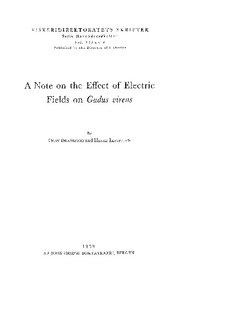| dc.description.abstract | To test electrotaxis earlier experiments have been performed in
relatively small tanks. It was felt, therefore that the arrangement with
a comparatively big tank would give greater allowance for a more varied
behaviour of the animal. This varied beliaviour pattern, however,
introduced an uncertainty as to which kind of change in behaviour
should be termed electrotaxis. The data have been listed in Table I.
As will be seen from the table the spread of data is considerable. A statistical
test of the data was tried, therefore, by applying the analysis of
variance. For changes in pulse duration there are significant differences
(F = 7.72; P < 0.05). As the pulse duration is lengthened, lower voltage
gradients are required to elicit the electrotactic responze. This is in
accordance with earlier findings. (MORGAN, 1953; BARY, 1956; and
others). For changes in frequency no significant differences could be
found when the material was treated as a step by step rise of 5 c/s. The
number of observations at each frequency is small, and if the material
is grouped in higher (30-50 c/s.) and lower (10-25 c/s.) frequencies,
a slightly significant difference can be found (F = 4.52; P < 0.05).
The relation this time being that a rise in frequency leads to an increase
in the voltage needed for electrotaxis. BARY (1956) showed that the
voltage gradient required for electrotaxis does not change with frequencies
above 5 c/s.
It was observed during our experiments that a more cramped swimming
would be encountered at the higher frequencies, making it
difficult to distinguish an electrotactic behaviour. The apparent rise
with frequency in the required voltage gradient found by grouping the
data, might be caused by this difficulty.
It seems difficult to suggest any reason for the differences in sensitivity
between Gadus virens and Mugil auratus. For a corresponding size
and pulse duration BARY (1956) found for Mugil auratus a potential
difference along the fish of arounct 7 v., whereas the present investigation
yields 2.5 v. for Gadus virens.
Many suggestions have been made as to the physiological events
underlying the electrotactic behaviour. For the future discussion on the
topic, we wish to draw attention to the following observation: Even at
voltages higher than the minimum for electrotaxis the effect on the
animal was seldom so strong that it overshadowed the animals sensual
perseption of the tank walls: The fish would usually turn before hitting
the tank wall. Exceptions here are again during the cramped movements
accompanying the higher frequencies. | |
